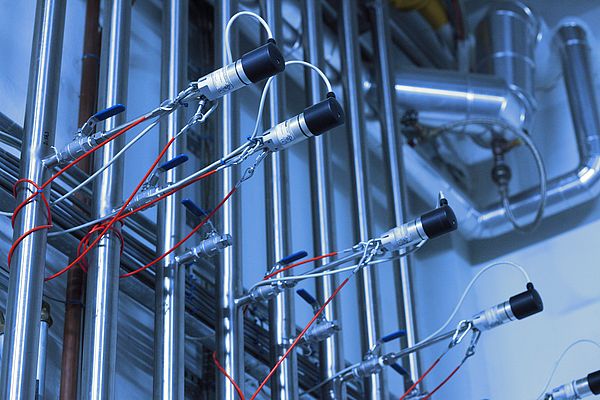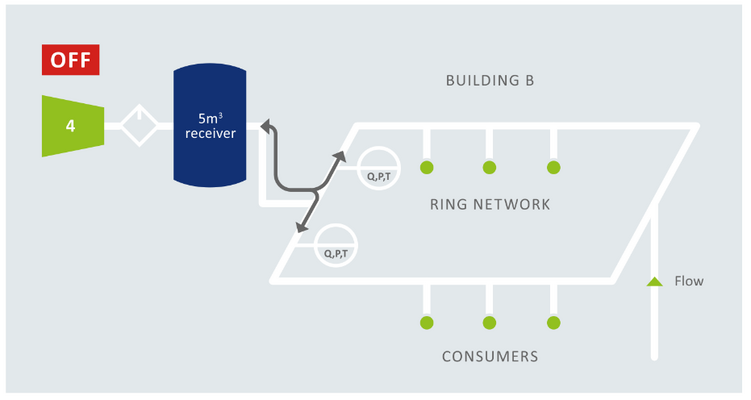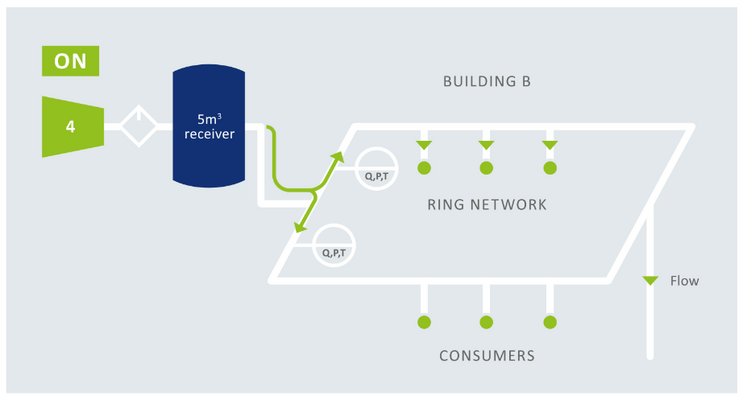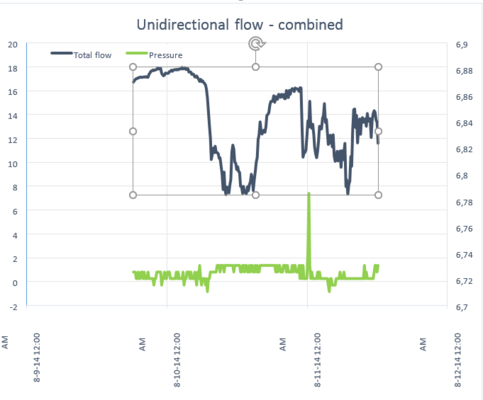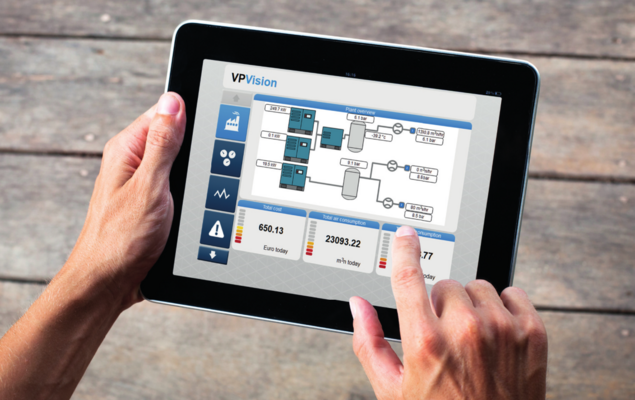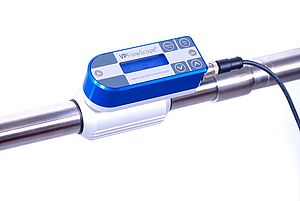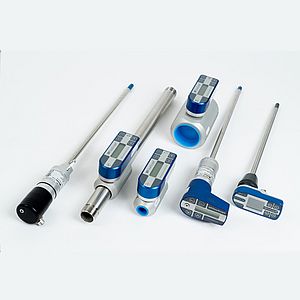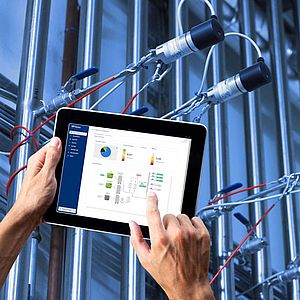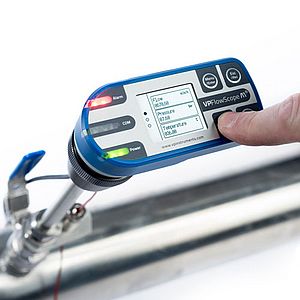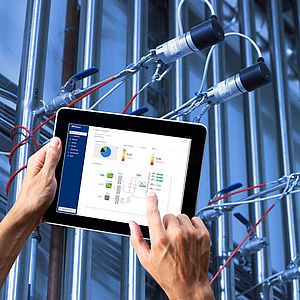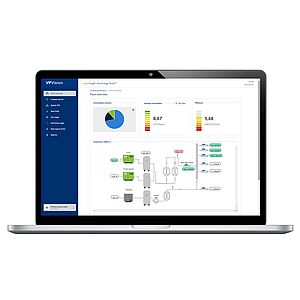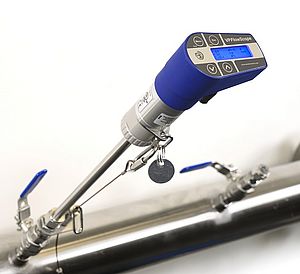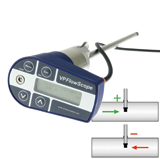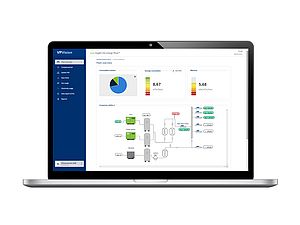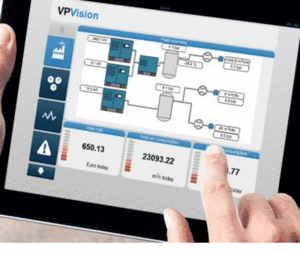The VPFlowScope compressed air flow meter is designed around a unique measurement principle. This enables you to measure not only the magnitude of the flow, but also the direction. In this article we will show two examples where bi-directional flow measurement plays a key role to come to the right conclusions.
Thermabridge technology
The original Thermabridge sensor combines flow direction measurement with thermal mass flow sensing over a full 0…150 mn/sec range. This enables you to measure flow in complex ring networks, where any other flow meters would deliver very unreliable measurement results.
Case 1. Two compressor rooms
At a large electronic component manufacturer, compressed air is used for the entire production process: injection molding machines, picking and placing of components, plating and galvanizing metal parts. An energy management program has been initiated to reduce the overall energy consumption of the plant. Compressed air was one of the utilities that needed attention. The compressors in the factory were quite old and there was room for improvement. To select the right compressor, the demand profile of the factory needed to be measured. But the company realized that permanent monitoring is key to long term savings. So instead of hiring an audit firm to perform a temporarily audit, they selected VPInstruments to implement a permanent monitoring solution. Initial goals for phase 1 of the project were:
- Establish a base line profile
- Select a replacement compressor (combination) based on this profile
- Identify waste, and reduce air demand of production areas.
During phase 1 of the project, we installed four flow meters to get a clear picture of the average demand. But after a couple of months, we encountered an interesting situation where standard uni-directional air flow meters would provide useless results. In this particular situation, back-flow towards the receiver tanks caused wrong readings, resulting in severe measurement errors.
System description
The compressed air system consisted of two compressor rooms (A and B). A compressed air ring network is supplied from these two separate compressor rooms. The compressor rooms are controlled with a pressure-based control system. At compressor room B, two flow meters are installed in a ring network to measure the air delivered to the network by a compressor. Between this compressor and the network, a large receiver tank (5 m3) is installed. In room A, three Atlas Copco screw compressors were located. Each compressor is fitted with a heat of compression drum drier. Between the pipes and the compressors, two large receivers are installed, 5 m3 each. From the receivers, two separate pipes supply air to the production processes. One pipe is connected to another building where compressor room B is located. The distance between the two compressor rooms is approximately 500 feet.
In compressor room B, one relatively new air cooled ZT 145 machine is located. Air leaves the compressor via a heat of compression drum drier and after the drum drier, another large receiver tank. Due to space limitations, it was not possible to install a single flow meter between the 5m3 receiver tank outlet and the network. Instead, two flow meters were installed further away, in the ring network, just after a T-junction, where the compressed air was fed into the ring. Initially, these VPFlowScope flow meters were unidirectional. In other words: They would not see the difference between forward and backward flow. After a couple of days, strange measurements were observed. The flow meters were showing considerable measurement values when the compressor was turned off.
Reverse flow or not?
After taking a closer look into compressor room B’s configuration, we came to the conclusion that there has to be reverse flow when the compressor is turned off.
Compressor in room B off: receiver tank behavior
During unload and off hours, the two uni-directional flow meters showed consumption, while one would expect zero flow. The large receiver tank is filled by the other compressors (from room A) when the local air demand in the ring network is low, and it delivers air to the network when the local demand is high.
Compressor in room B on: “merging traffic” situation
When the compressor is running loaded, compressed air is fed into the ring network. In the T-junction, the flow merges with existing “traffic” based on how the consumption in the ring mains is balanced. If the consumption is well balanced, it might be perfectly symmetric (50% left, 50% right), but when the consumption on one side is much higher, the air flow will distribute differently. Pulsating demand can also change the flow distribution for a short period of time. The air coming from the compressor merges with the air which was already flowing through the ring network. This can result in a high or low reading, depending on the actual demand and the resulting flow direction.
Uni-directional versus bi-directional
A uni-directional flow meter does not have a clue where the air is coming from. This results in large errors. This applies to most thermal mass flow meters based on thermal dispersion, constant temperature anemometry and so on. The differential pressure signal will not change to negative when flow is reversed. Orifice meters can also measure reverse flow, but they are not so suitable for compressed air due to their permanent pressure loss. By turning on the bi-directional sensing feature of the VPFlowScope, the changing of flow direction is instantaneously revealed.
Case 2. Decentralized receivers
In some cases, a decentralized receiver tank is used to “shave off” the peak load on the network. A question often asked: where to place the flow meter, and what will the flow meter show us when the machine has been turned off. This part of the article is based on an older audit at a potato food processing plant, where we used a standard thermal mass flow meter without bi-directional sensitivity. The auditor called us after a couple of days, to discuss the results. The flow meter showed significant consumption while the machine was isolated from the network. The receiver tank was simply acting as a local buffer for machines further downstream the line. It was filled, and emptied at the pace of their consumption, causing significant readings on the thermal mass flow meter. In this case, the issue was finally resolved by ignoring the data during the period when the machine was shut off.
Other issues you can discover with bi-directional sensors:
Bi-directional flow meters can reveal important issues in many compressed air systems. Other examples where you can reveal issues: leaking non-return valves just after the compressor or leaking condensate drains. The bi-directional flow meter will tell you when it happens.
Combining the results using virtual channels
In the central VPVision energy monitoring software, using a virtual channel, data of two flow meters can be combined into one signal. The channel adds/ subtracts all measurement values, based on their flow direction.



